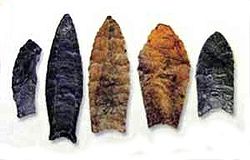This article is more than 1 year old
Genetics and technology make Columbus Day a fraud
But who cares, it’s a day off
Don't forget the Irish, Romans, and Mormons
Vikings did settle here, as the settlement of L'Anse aux Meadows shows, but never in great numbers. It’s possible Erikson that wasn’t believed – after all, his dad had named a hunk of ice shelf Greenland to encourage settlement – but a more likely reason for the lack of migration was that the technology and the tools for the job just weren’t there.
The kind of trees needed to build the Viking ships weren’t found on Iceland or Greenland, meaning if you were shipwrecked you were essentially stuck. As an additional disincentive, the Vikings were busy conquering more agreeable lands in Britain, France, and Russia. The story passed into verbal history, and it was centuries before the sagas even made it onto paper.
The Irish also lay claim to the title of first Europeans to land on the New World. In around 500 AD the Irish St. Brendan apparently made a trip out west in a boat made of ox hides, and discovered new lands full of strange people and stranger monsters. Explorer Tim Severin made a transatlantic trip in a replica boat made of 49 ox skins in 1977. He made it, but described the entire trip as too dangerous to contemplate doing again.
The Mormons also believe that, in fact, they were first. The books of that faith relate how, around 600 BC, the prophet Lehi, his family, and his followers crammed onto boats and sailed west until they found the Americas, and there set up civilization. Basic genetics shows this to be a fairy story, but that hasn’t stopped the Church of the Latter Day Saints from becoming a powerful US religion.
The two great maritime nations of the pre-Christian era, Rome and Carthage, may also have made it across the Atlantic. The Romans certainly colonized the Canary Islands, and it’s not inconceivable that some adventurer took a trireme and headed west. The Carthaginians carried out extensive voyages around Africa, and a westerly jaunt may also have attracted interest.
But for the title of the oldest Europeans to make the trip to America, it now seems as though all of the above were hopelessly behind the times. The scientific community is currently debating if the first Europeans arrived here not hundreds of years ago, but over 15,000. The Solutrean hypothesis uses technology and genetics to suggest that Europeans were active in America before the invention of the written word.
The Solutreans are known chiefly for their flint knapping skills, and were the high tech wunderkind of their time. They discovered that heating flint enabled it to be worked much more finely, and used a variety of tools like percussive punches to use that flint more efficiently. It might not sound like a lot now, but flint was the silicon of its day, and the Solutreans created a range of beautiful and effective tools that were highly developed.

Clovis spearpoints, common across America, could have been a European import
This flint technology is very close in form to Clovis points, found scattered across North America, but is dissimilar to that used by the original Americans who crossed the Bering Sea land bridge. An increasing number of archeologists suggest that the Solutreans paddled across the northernmost part of the ice sheet, which during the last ice age extended from France to Southern Canada, using techniques similar to those used by the Arctic Inuit people today. They might not have spread far, but their technology did – or so the theory goes.
The jury, however, is very much still out on this one. Genetic evidence should be a good way to solve the mystery, but the results have been inconclusive.
The Haplogroup X DNA group is found in around three per cent of Americans, and other than that only in Europe and the Near East. It is found most commonly in those Native Americans who use the Algonquian language and are based in the Northeast US. While this is suggestive of a Solutrean link, the amount of variance in Haplogroup X suggests it could be a hangover from the first inhabitants of America, as opposed to being introduced across the Atlantic.
We may never know who really was the first European to make it onto dry land in the Americas – but it doesn’t really matter. Columbus was the one who made it here, publicized the trip and expanded onto the continent, so he gets the holiday. But it’s worth remembering that history is never cut and dried. ®
